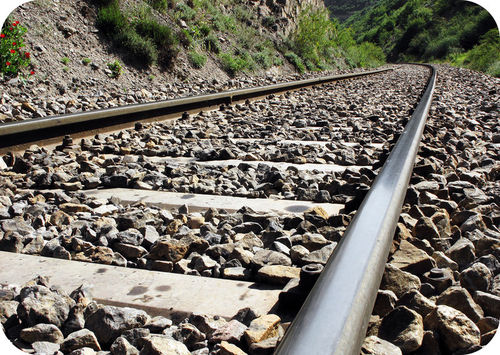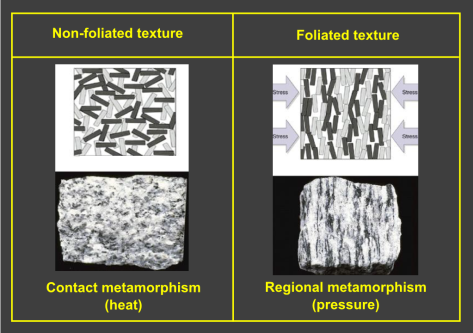23 Rocks and Rock Cycle (II): Metamorphism and Characteristics of Metamorphic Rocks
A metamorphic rock used to be some other type of rock, but it was changed inside the Earth to become a new type of rock. The word metamorphism comes from ancient Greek words for “change” (meta) and “form” (morph). The type of rock that a metamorphic rock used to be, prior to metamorphism, is called the protolith. During metamorphism the mineral content and texture of the protolith are changed due to changes in the physical and chemical environment of the rock. Metamorphism can be caused by burial, tectonic stress, heating by magma, or alteration by fluids. At advanced stages of metamorphism, it is common for a metamorphic rock to develop such a different set of minerals and such a thoroughly changed texture that it is difficult to recognize what the protolith was.
A rock undergoing metamorphism remains a solid rock during the process. Rocks do not melt during most conditions of metamorphism. At the highest grade of metamorphism, rocks begin to partially melt, at which point the boundary of metamorphic conditions is surpassed and the igneous part of the rock cycle is entered.
The following video explains the concept of metamorphism (can start from 0:53)
Even though rocks remain solid during metamorphism, fluid is generally present in the microscopic spaces between the minerals. This fluid phase may play a major role in the chemical reactions that are an important part of how metamorphism occurs. The fluid usually consists largely of water.
Metamorphic rocks provide a record of the processes that occurred inside Earth as the rock was subjected to changing physical and chemical conditions. This gives the geologist literally “inside information” on what occurs within the Earth during such processes as the formation of new mountain ranges, the collision of continents, the subduction of oceanic plates, and the circulation of sea water into hot oceanic crust.
Metamorphic rocks are like probes that have gone down into the Earth and come back, bringing an record of the conditions they encountered on their journey in the depths of the Earth.
Metamorphism is the addition of heat and/or pressure to existing rocks, which causes them to change physically and/or chemically so that they become a new rock. Metamorphic rocks may change so much that they may not resemble the original rock.
Any type of rock—igneous, sedimentary, or metamorphic—can become a metamorphic rock. All that is needed is enough heat and/or pressure to alter the existing rock’s physical or chemical makeup without melting the rock entirely.
Rocks change during metamorphism because the minerals need to be stable under the new temperature and pressure conditions. The need for stability may cause the structure of minerals to rearrange and form new minerals. Ions may move between minerals to create minerals of different chemical composition.
Figure below shows how shale (sedimentary rock) turns into gneiss (metamorphic rock) through a series of changes, causing new rocks (i.e. slate, phyllite and schist) to form from the so-called protolith, a “parent” or “primeval” rock that experienced metamorphism. In this case, shale is a protolith of slate, slate is a protolith of phyllite, etc.
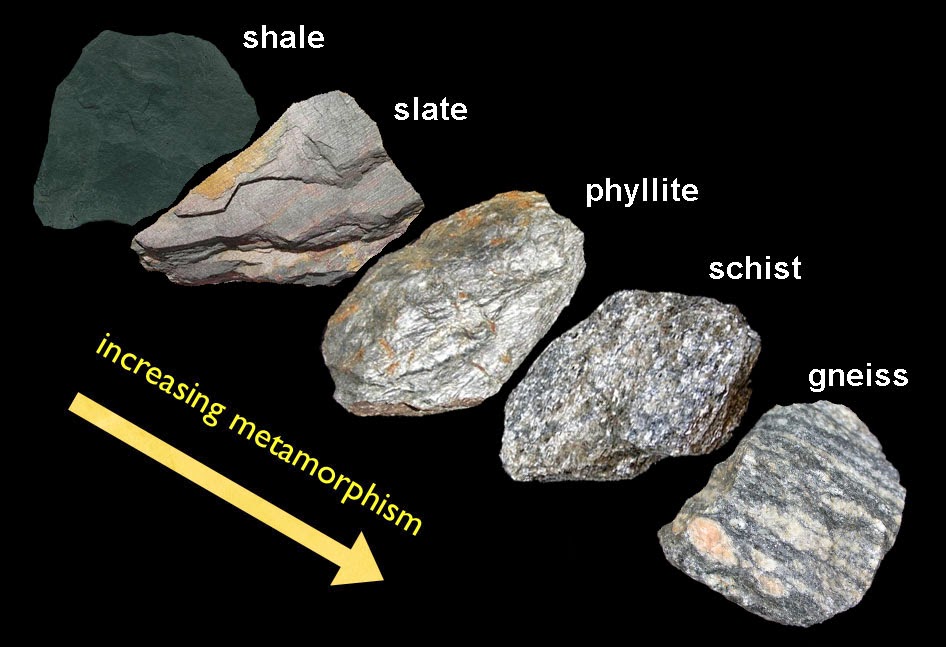
During mineralogical transformations new (index) minerals are formed:

Extreme pressure may also lead to foliation, the flat layers that form in rocks as the rocks are squeezed by pressure (Figure 2).
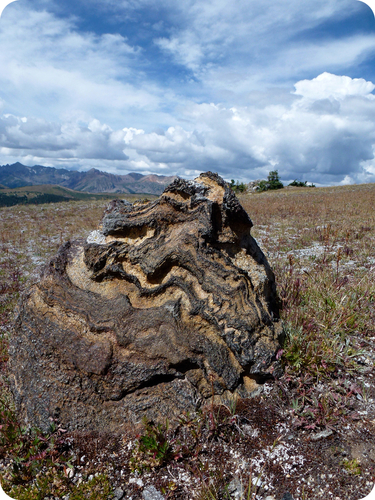
Figure 2. A foliated metamorphic rock.
Foliation normally forms when pressure is exerted in only one direction.
Metamorphic rocks may also be non-foliated. Quartzite and marble are nonfoliated. Marble is a result of chemical/physical changes in the limestone. Quartzite is a changed sandstone.
Quartzite rock
The two main types of metamorphism:
Regional metamorphism:
Changes in enormous quantities of rock over a wide area caused by the extreme pressure from overlying rock or from compression caused by geologic processes. Deep burial exposes the rock to high temperatures.
Regional metamorphism occurs where large areas of rock are subjected to large amounts of differential stress for long intervals of time, conditions typically associated with mountain building. Mountain building occurs at subduction zones and at continental collision zones where two plates each bearing continental crust, converge upon each other. We will cover this in more details in Plate Tectonics lecture.


Most foliated metamorphic rocks—slate, phyllite, schist, and gneiss—are formed during regional metamorphism. Their protoliths are oceanic sedimentary rocks – mudstones (shales), siltstones. In some case the protliths for gneiss and schist can be a quartzite, metamorphic rock formed by the contact metamorphism from the sandstone.
As the rocks become heated at depth in the Earth during regional metamorphism they become ductile, which means they are relatively soft even though they are still solid. The folding and deformation of the rock while it is ductile may greatly distort the original shapes and orientations of the rock, producing folded layers and mineral veins that have highly deformed or even convoluted shapes. The diagram below shows folds forming during an early stage of regional metamorphism, along with development of foliation, in response to normal stress.

The photograph below shows high-grade metamorphic rock that has undergone several stages of foliation development and folding during regional metamorphism, and may even have reached such a high temperature that it began to melt.

Gneiss: an example of regional metamorphism rocks, conversion from schist
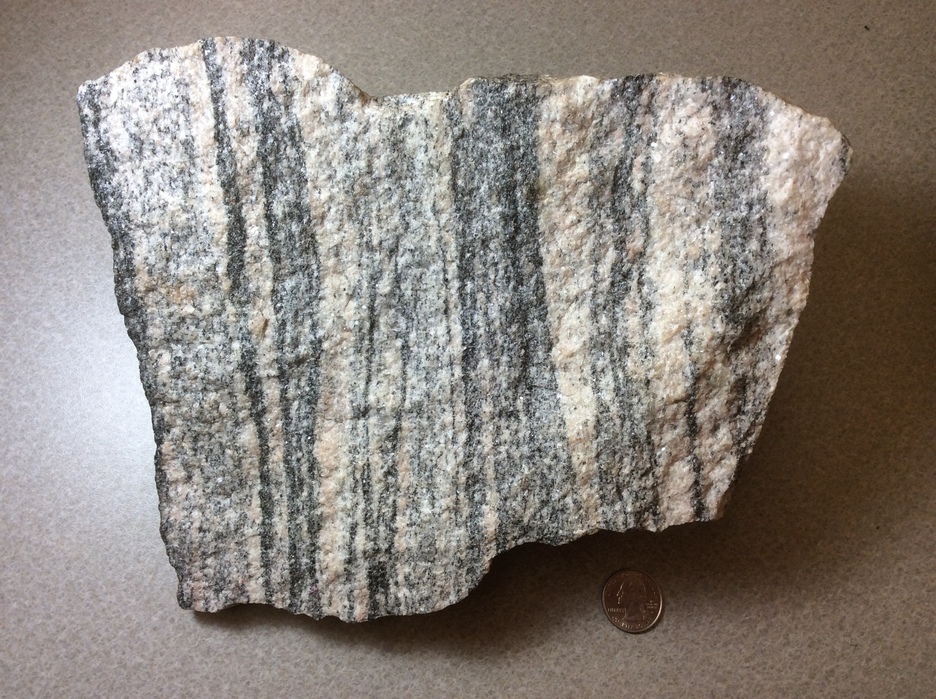

Contact metamorphism:
Changes in a rock that is in contact with magma because of the magma’s extreme heat.
Contact metamorphism occurs to solid rock next to an igneous intrusion and is caused by the heat from the nearby body of magma. Because contact metamorphism is not caused by changes in pressure or by differential stress, contact metamorphic rocks do not become foliated. Where intrusions of magma occur at shallow levels of the crust, the zone of contact metamorphism around the intrusion is relatively narrow, sometimes only a few m (a few feet) thick, ranging up to contact metamorphic zones over 1000 m (over 3000 feet) across around larger intrusions that released more heat into the adjacent crust.
The zone of contact metamorphism surrounding an igneous intrusion is called the metamorphic aureole. The rocks closest to the contact with the intrusion are heated to the highest temperatures, so the metamorphic grade is highest there and diminishes with increasing distance away from the contact. Because contact metamorphism occurs at shallow to moderate depths in the crust and subjects the rocks to temperatures up to the verge of igneous conditions, it is sometimes referred to as high-temperature, low-pressure metamorphism.
Hornfels, which is a hard metamorphic rock formed from fine-grained clastic sedimentary rocks (shales, marls, etc.), is a common product of contact metamorphism. Limestone is another example: with intrusion contact it becomes marble. Quartz rich sandstone (arcose, arenite) at the contact with intrusion becomes a quartzite.
Marble: contact metamorphism, conversion from carbonate (limestone) rocks.
One of the largest and most known marble quarries is located in Carrara, Italy. Marble from Carrara was used by Leonardo Da Vinci, Michelangelo and Bernini for their sculptures. It was used in most of European cities and is being still used now.
Image below (from Google Earth) shows the size of this quarry, being used since antiquity and possibly earlier. See Wikipedia article on this: https://en.wikipedia.org/wiki/Carrara_marble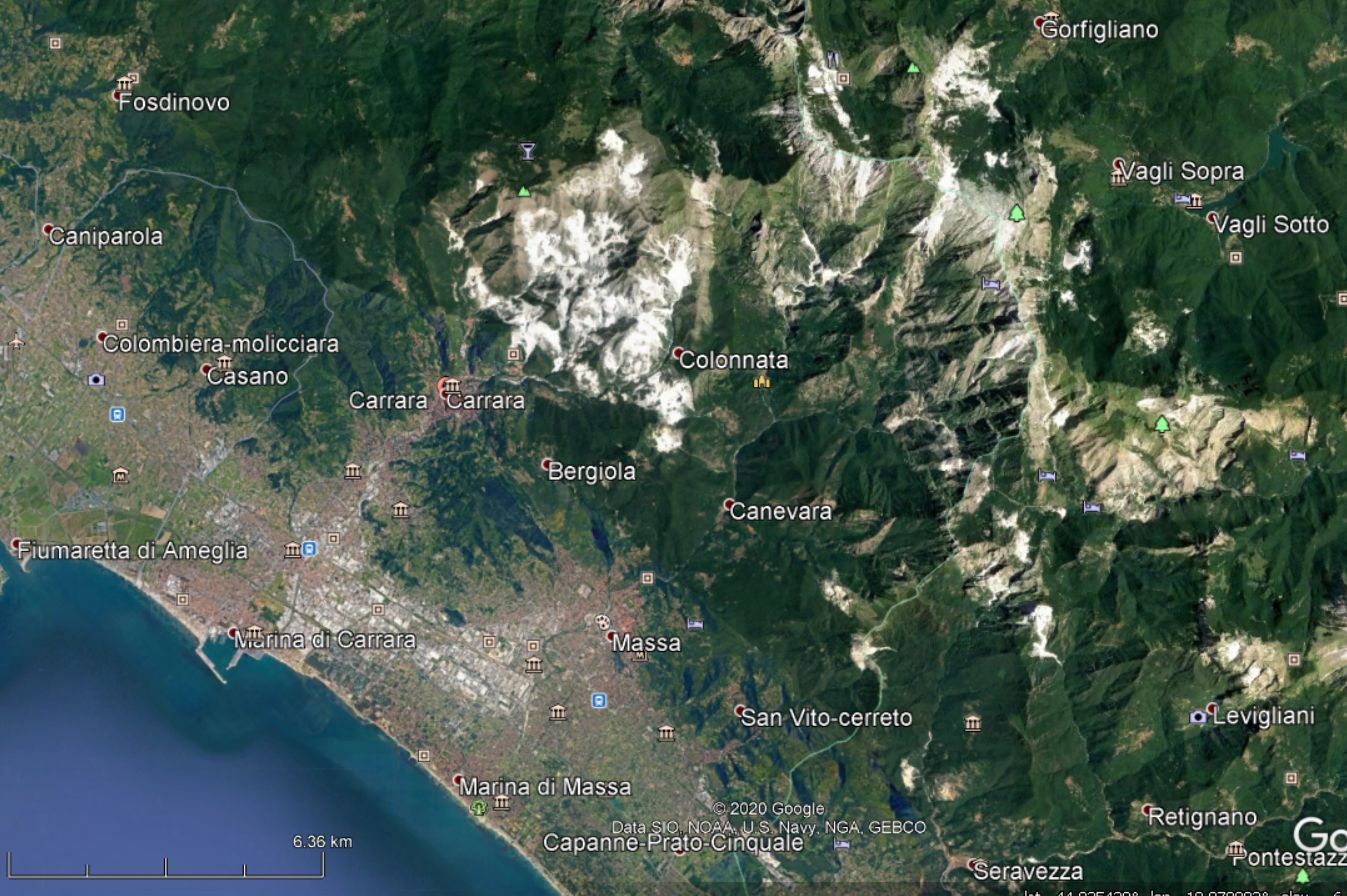
Let’s make a trip to Carrara:
Factors that Control Metamorphism:
The reason rocks undergo metamorphism is that the minerals in a rock are only stable under a limited range of pressure, temperature, and chemical conditions. When rocks are subjected to large enough changes in these factors, the minerals will undergo chemical reactions that result in their replacement by new minerals, minerals that are stable in the new conditions.
Chemical Composition of the Protolith
The type of rock undergoes metamorphism is a major factor in determining what type of metamorphic rock it becomes. In short the identify of the protolith plays a big role the identity of the metamorphic rock. A fluid phase may introduce or remove chemical substances into or out of the rock during metamorphism, but in most metamorphic rock, most of the atoms in the protolith are be present in the metamorphic rock after metamorphism; the atoms will likely be rearranged into new mineral forms within the rock. Therefore, not only does the protolith determine the initial chemistry of the metamorphic rock, most metamorphic rocks do not change their bulk (overall) chemical compositions very much during metamorphism. The fact that most metamorphic rocks retain most of their original atoms means that even if the rock was so thoroughly metamorphosed that it no longer looks at all like the protolith, the rock can be analyzed in terms of its bulk chemical composition to determine what type of rock the protolith was.
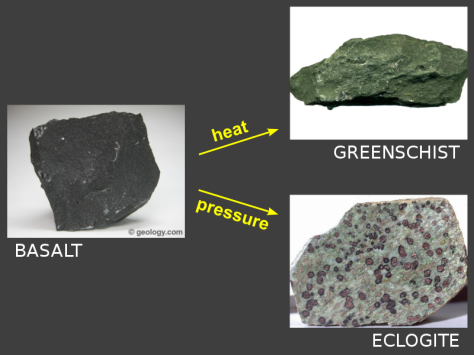
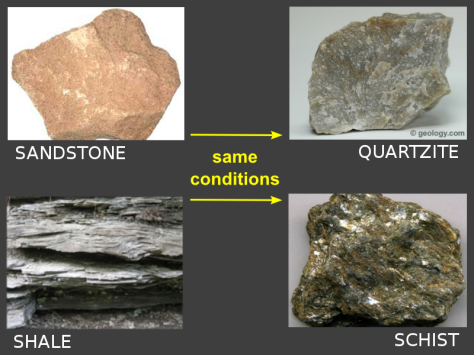
Source: https://leakuhta.wordpress.com/2013/11/18/under-pressure-metamorphic-rocks/
Temperature
Temperature is another major factor of metamorphism, especially contact metamorphism. There are two ways to think about how the temperature of a rock can be increased as a result of geologic processes.
If rocks are buried within the Earth, the deeper they go, the higher the temperatures they experience. This is because temperature inside the Earth increases with depth; this is known as the geothermal gradient, or geotherm for short. Therefore, if rocks are simply buried deep enough enough sediment, they will experience temperatures high enough to cause metamorphism. This temperature is about 200ºC (approximately 400ºF).
Tectonic processes are another way rocks can be moved deeper along the geotherm. Faulting and folding the rocks of the crust, can move rocks to much greater depth than simple burial can.
Yet another way a rock in the Earth’s crust can have its temperature greatly increased is by the intrusion of magma nearby. Magma intrusion subjects nearby rock to higher temperature with no increase in depth or pressure.
Pressure
Pressure is a measure of the stress, the physical force, being applied to the surface of a material. It is defined as the force per unit area acting on the surface, in a direction perpendicular to the surface.
Lithostatic pressure is the pressure exerted on a rock by all the surrounding rock. The source of the pressure is the weight of all the rocks above. Lithostatic pressure increases as depth within the Earth increases and is a uniform stress—the pressure applies equally in all directions on the rock.
If pressure does not apply equally in all directions, differential stress occurs. There are two types of differential stress.
Normal stress compresses (pushes together) rock in one direction, the direction of maximum stress. At the same time, in a perpendicular direction, the rock undergoes tension (stretching), in the direction of minimum stress.
Shear stress pushes one side of the rock in a direction parallel to the side, while at the same time, the other side of the rock is being pushed in the opposite direction.
Differential stress has a major influence on the the appearance of a metamorphic rock. Differential stress can flatten pre-existing grains in the rock, as shown in the diagram below.
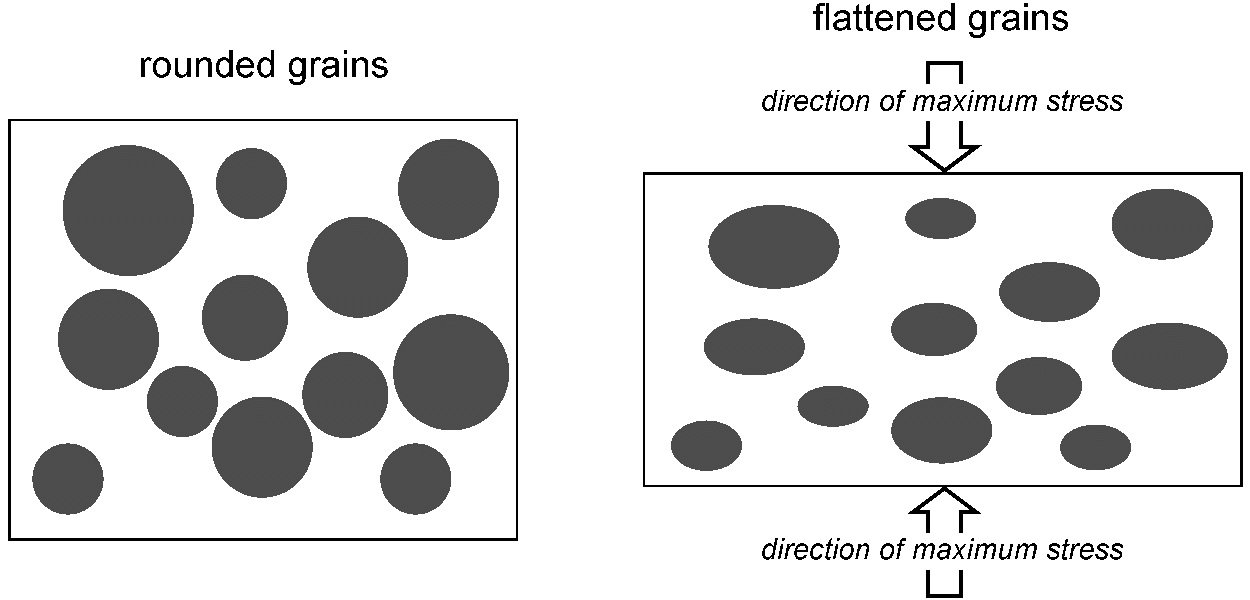
Metamorphic minerals that grow under differential stress will have a preferred orientation if the minerals have atomic structures that tend to make them form either flat or elongate crystals. This will be especially apparent for micas or other sheet silicates that grow during metamorphism, such as biotite, muscovite, chlorite, talc, or serpentine. If any of these flat minerals are growing under normal stress, they will grow with their sheets oriented perpendicular to the direction of maximum compression. This results in a rock that can be easily broken along the parallel mineral sheets. Such a rock is said to be foliated, or to have foliation.
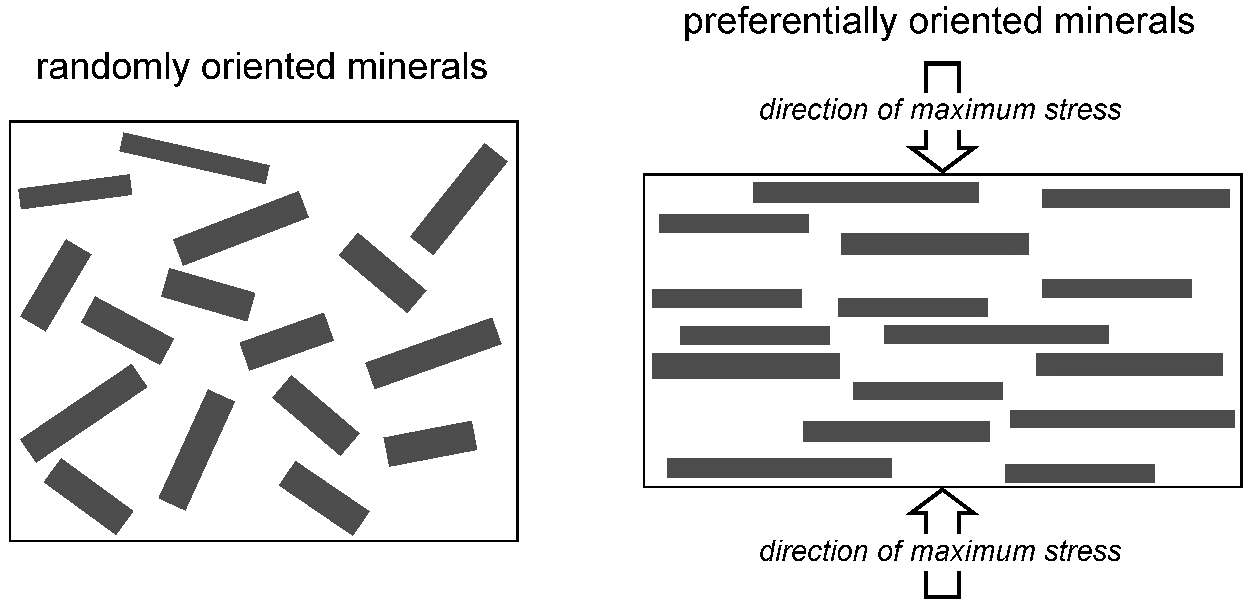
SUMMARY: Heat and Pressure
Source: https://leakuhta.wordpress.com/2013/11/18/under-pressure-metamorphic-rocks/
Fluids
Any open space between the mineral grains in a rock, however microscopic, may contain a fluid phase. Most commonly, if there is a fluid phase in a rock during metamorphism, it will be a hydrous fluid, consisting of water and things dissolved in the water. Less commonly, it may be a carbon dioxide fluid or some other fluid. The presence of a fluid phase is a major factor during metamorphism because it helps determine which metamorphic reactions will occur and how fast they will occur. The fluid phase can also influence the rate at which mineral crystals deform or change shape. Most of this influence is due to the dissolved ions that pass in and out of the fluid phase. If during metamorphism enough ions are introduced to or removed from the rock via the fluid to change the bulk chemical composition of the rock, the rock is said to have undergone metasomatism. However, most metamorphic rocks do not undergo sufficient change in their bulk chemistry to be considered metasomatic rocks.
Time
Most metamorphism of rocks takes place slowly inside the Earth. Regional metamorphism takes place on a timescale of millions of years. Metamorphism usually involves slow changes to rocks in the solid state, as atoms or ions diffuse out of unstable minerals that are breaking down in the given pressure and temperature conditions and migrate into new minerals that are stable in those conditions. This type of chemical reaction takes a long time.
Grades of Metamorphism
Metamorphic grade refers to the general temperature and pressure conditions that prevailed during metamorphism. As the pressure and temperature increase, rocks undergo metamorphism at higher metamorphic grade. Rocks changing from one type of metamorphic rock to another as they encounter higher grades of metamorphism are said to be undergoing prograde metamorphism.
Low-grade metamorphism takes place at approximately 200–320 ºC and relatively low pressure. This is not far beyond the conditions in which sediments get lithified into sedimentary rocks, and it is common for a low-grade metamorphic rock to look somewhat like its protolith. Low grade metamorphic rocks tend to characterized by an abundance of hydrous minerals, minerals that contain water within their crystal structure. Examples of low grade hydrous minerals include clay, serpentine, and chlorite. Under low grade metamorphism many of the metamorphic minerals will not grow large enough to be seen without a microscope.
Medium-grade metamorphism takes place at approximately at 320–450 ºC and at moderate pressures. Low grade hydrous minerals are replaced by micas such as biotite and muscovite, and non-hydrous minerals such as garnet may grow. Garnet is an example of a mineral which may form porphyroblasts, metamorphic mineral grains that are larger in size and more equant in shape (about the same diameter in all directions), thus standing out among the smaller, flatter, or more elongate minerals.
High-grade metamorphism takes place at temperatures above about 450 ºC. Micas tend to break down. New minerals such as hornblende will form, which is stable at higher temperatures. However, as metamorphic grade increases to even higher grade, all hydrous minerals, which includes hornblende, may break down and be replaced by other, higher-temperature, non-hydrous minerals such as pyroxene.
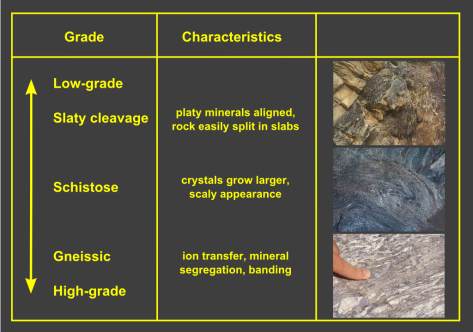
Source: https://leakuhta.wordpress.com/2013/11/18/under-pressure-metamorphic-rocks/
Index Minerals
Index minerals, which are indicators of metamorphic grade. In a given rock type, which starts with a particular chemical composition, lower-grade index minerals are replaced by higher-grade index minerals in a sequence of chemical reactions that proceeds as the rock undergoes prograde metamorphism. For example, in rocks made of metamorphosed shale, metamorphism may prograde through the following index minerals:
- chlorite characterizes the lowest regional metamorphic grade
- biotite replaces chlorite at the next metamorphic grade, which could be considered medium-low grade
- garnet appears at the next metamorphic grade, medium grade
- staurolite marks the next metamorphic grade, which is medium-high grade
- sillimanite is a characteristic mineral of high grade metamorphic rocks
Index minerals are used by geologists to map metamorphic grade in regions of metamorphic rock. A geologist maps and collects rock samples across the region and marks the geologic map with the location of each rock sample and the type of index mineral it contains. By drawing lines around the areas where each type of index mineral occurs, the geologist delineates the zones of different metamorphic grades in the region. The lines are known as isograds.
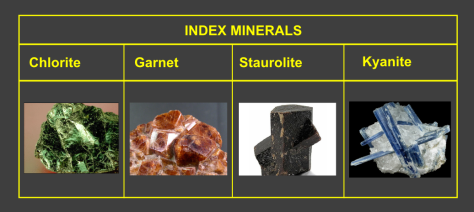 Low grade: chlorite and muscovite
Low grade: chlorite and muscovite
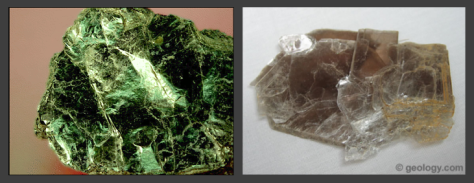 Medium grade: Biotite, garnet & staurolite
Medium grade: Biotite, garnet & staurolite
 Higher grade: kyanite
Higher grade: kyanite
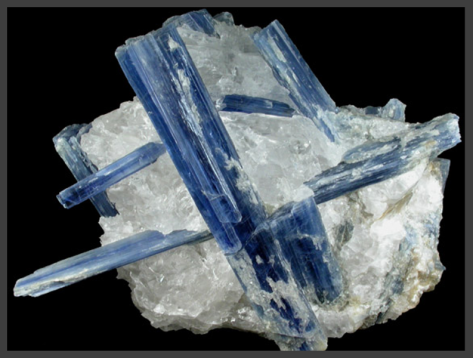 Highest grade: sillimanite and alkali feldspar
Highest grade: sillimanite and alkali feldspar
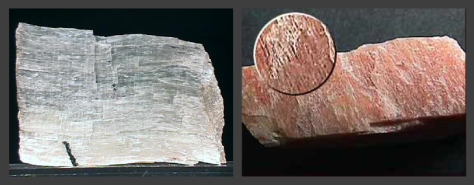
Source: https://leakuhta.wordpress.com/2013/11/18/under-pressure-metamorphic-rocks/
Other types of metamorphism:
Hydrothermal Metamorphism
Hydrothermal metamorphism is the result of extensive interaction of rock with high-temperature fluids. The difference in composition between the existing rock and the invading fluid drives the chemical reactions. The hydrothermal fluid may originate from a magma that intruded nearby and caused fluid to circulate in the nearby crust, from circulating hot groundwater, or from ocean water. If the fluid introduces substantal amounts of ions into the rock and removes substantial amounts of ions from it, the fluid has metasomatized the rock—changed its chemical composition.
Ocean water that penetrates hot, cracked oceanic crust and circulates as hydrothermal fluid in ocean floor basalts produces extensive hydrothermal metamorphism adjacent to mid-ocean spreading ridges and other ocean-floor volcanic zones. Much of the basalt subjected to this type of metamorphism turns into a type of metamorphic rock known as greenschist. Greenschist contains a set of minerals, some of them green, which may include chlorite, epidote, talc, Na-plagioclase, or actinolite. The fluids eventually escape through vents in the ocean floor known as black smokers, producing thick deposits of minerals on the ocean floor around the vents.
Hydrothermal activity results in various ores and minerals
Burial Metamorphism
Burial metamorphism occurs to rocks buried beneath sediments to depths that exceed the conditions in which sedimentary rocks form. Because rocks undergoing burial metamorphism encounter the uniform stress of lithostatic pressure, not differential pressure, they do not develop foliation. Burial metamorphism is the lowest grade of metamorphism. The main type of mineral that usually grows during burial metamorphism is zeolite, a group of low-density silicate minerals. It usually requires a strong microscope see the small grains of zeolite minerals that form during burial metamorphism.
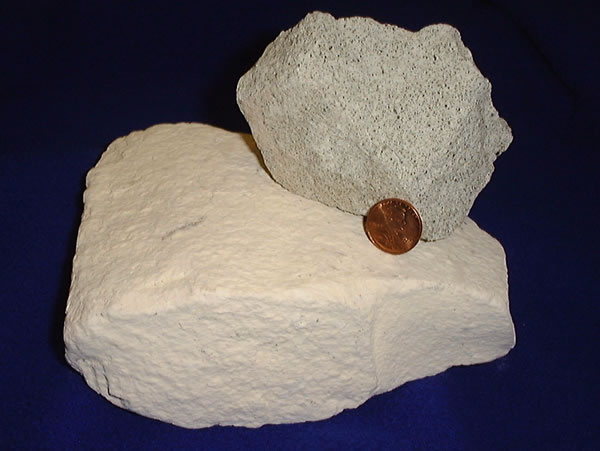 Source: https://en.wikipedia.org/wiki/Zeolite Used a lot in water purification processes.
Source: https://en.wikipedia.org/wiki/Zeolite Used a lot in water purification processes.
Metamorphic Facies
Much as the minerals and textures of sedimentary rocks can be used as windows to see into the environment in which the sediments were deposited on the Earth’s surface, the minerals and textures of metamorphic rocks provide windows through which we view the conditions of pressure, temperature, fluids, and stress that occurred inside the Earth during metamorphism. The pressure and temperature conditions under which specific types of metamorphic rocks form has been determined by a combination of laboratory experiments, physics-based theoretical calculations, along with evidence in the textures of the rocks and their field relations as recorded on geologic maps. The knowledge of temperatures and pressures at which particular types of metamorphic rocks form led to the concept of metamorphic facies. Each metamorphic facies is represented by a specific type of metamorphic rock that forms under a specific pressure and temperature conditions.
The diagram below shows metamorphic facies in terms of pressure and temperature conditions inside the Earth. Earth’s surface conditions are near the top left corner of the graph at about 15ºC which is the average temperature at Earth’s surface and 0.1 MPa (megapascals), which is about the average atmospheric pressure on the Earth’s surface. Just as atmospheric pressure comes from the weight of all the air above a point on the Earth’s surface, pressure inside the Earth comes from the weight of all the rock above a given depth.
Rocks are much denser than air and MPa is the unit most commonly uses to express pressures inside the Earth. One MPa equals nearly 10 atmospheres. A pressure of 1000 MPa corresponds to a depth of about 35 km inside the Earth. Although pressure inside the Earth is determined by the depth, temperature depends on more than depth. Temperature depends on the heat flow, which varies from location to location. The way temperature changes with depth inside the Earth is called the geothermal gradient, geotherm for short. In the diagram below, three different geotherms are marked with dashed lines. The three geotherms represent different geological settings in the Earth.
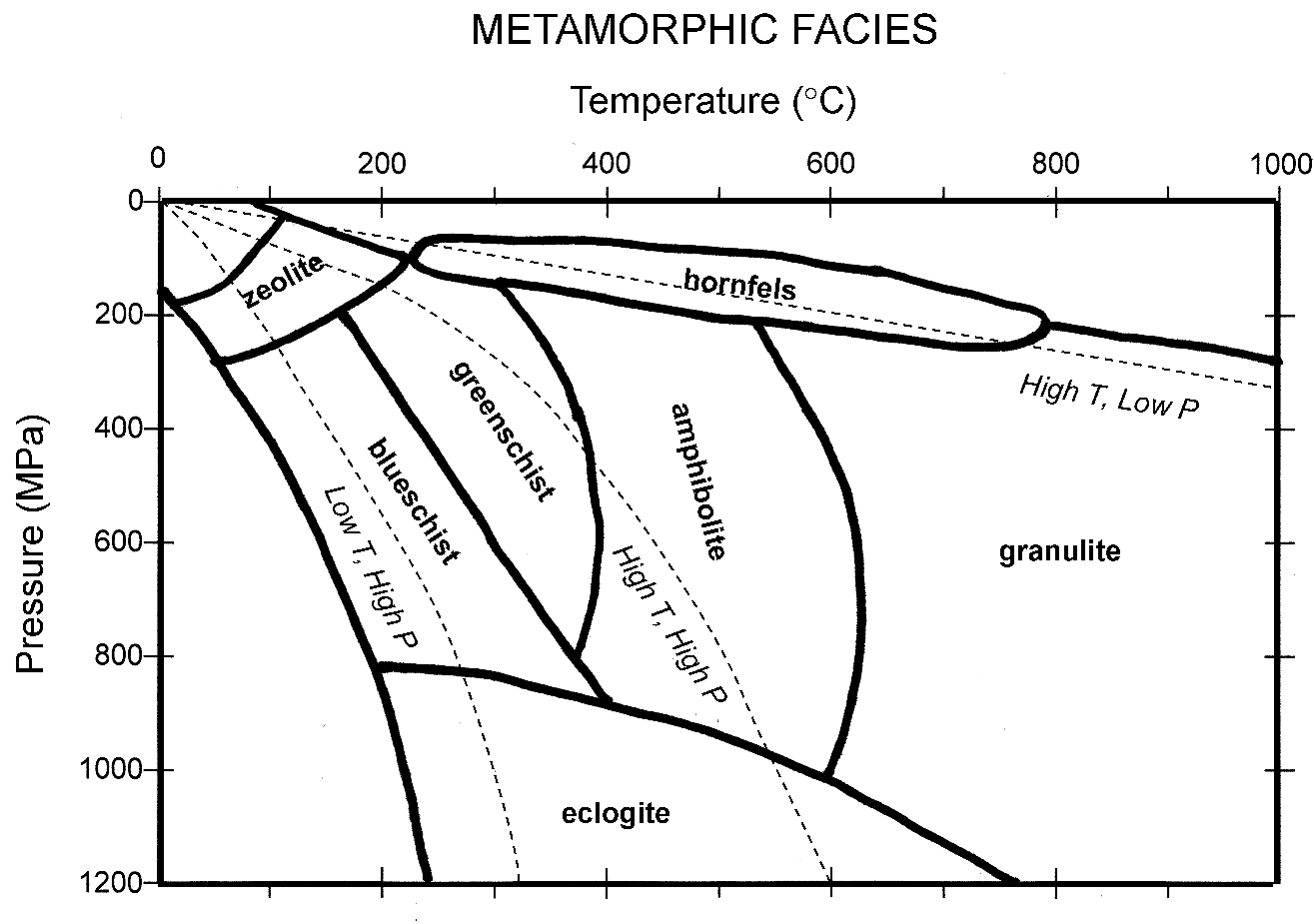
High-pressure, low-temperature geotherms occurs in subduction zones where oceanic crust converges with continental crust.
As the diagram shows, rocks undergoing prograde metamorphism in subduction zones will be subjected to zeolite, blueschist, and ultimately eclogite facies conditions.
High-temperature, low-pressure geotherms occur in the vicinity of igneous intrusions in the shallow crust, underlying a volcanically active area. Rocks that have their pressure and temperature conditions increased along such a geotherm will metamorphose in the hornfels facies and, if it gets hot enough, in the granulite facies.
Blueschist facies and hornfels facies are associated with unusual geothermal gradients. The most common conditions in the Earth are found along geotherms between those two extremes. Most regional metamorphic rocks are formed in conditions within this range of geothermal gradients, passing through the greenschist facies to the amphibolites facies. At the maximum pressures and temperatures the rocks may encounter within the Earth in this range of geotherms, they will enter either the granulite or eclogite facies. Regionally metamorphosed rocks that contain hydrous fluids will begin to melt before they pass beyond the amphibolite facies.
Summary: Types of Metamorphic Rocks
Metamorphic rock fall into two categories, foliated and unfoliated.
Most foliated metamorphic rocks originate from regional metamorphism. Some unfoliated metamorphic rocks, such as hornfels, originate only by contact metamorphism, but others can originate either by contact metamorphism or by regional metamorphism. Quartz and marble are prime examples of unfoliated that can be produced by either regional or contact metamorphism. Both rock types consist of metamorphic minerals that do not have flat or elongate shapes and thus cannot become layered even if they are produced under differential stress.
A geologist working with metamorphic rocks collects the rocks in the field and looks for the patterns the rocks form in outcrops as well as how those outcrops are related to other types of rock with which they are in contact. Field evidence is often required to know for sure whether rocks are products of regional metamorphism, contact metamorphism, or some other type of metamorphism. If only looking at rock samples in a laboratory, one can be sure of the type of metamorphism that produced a foliated metamorphic rock such as schist or gneiss, or a hornfels, which is unfoliated, but one cannot be sure of the type of metamorphism that produced an unfoliated marble or quartzite.
Foliated Metamorphic Rocks
Foliated metamorphic rocks are named for their style of foliation. However, a more complete name of each particular type of foliated metamorphic rock includes the main minerals that the rock comprises, such as biotite-garnet schist rather than just schist.
- slate—slates form at low metamorphic grade by the growth of fine-grained chlorite and clay minerals. The preferred orientation of these sheet silicates causes the rock to easily break along parallel planes, giving the rock a slaty cleavage. Some slate breaks into such extensively flat sheets of rock that it is used as the base of pool tables, beneath a layer of rubber and felt. Roof tiles are also sometimes made of slate.
- phyllite—phyllite is a low-medium grade regional metamorphic rock in which the clay minerals and chlorite have been at least partly replaced by mica mica minerals, muscovite and biotite. This gives the surfaces of phyllite a satiny luster, much brighter than the surface of a piece of slate. It is also common for the differential stresses under which phyllite forms to have produced a set of folds in the rock, making the foliation surfaces wavy or irregular, in contrast to the often perfectly flat surfaces of slaty cleavage.
- schist—the size of mineral crystals tends to grow larger with increasing metamorphic grade. Schist is a product of medium grades of metamorphism and is characterized by visibly prominent, parallel sheets of mica or similar sheet silicates, usually either muscovite or biotite, or both. In schist, the sheets of mica are usually arranged in irregular planes rather than perfectly flat planes, giving the rock a schistose foliation (or simply schistosity). Schist often contains more than just micas among its minerals, such as quartz, feldspars, and garnet.
- amphibolite—a poorly foliated to unfoliated mafic metamorphic rock, usually consisting largely of the common black amphibole known as hornblende, plus plagioclase, plus or minus biotite and possibly other minerals; it usually does not contain any quartz. Amphibolite forms at medium-high metamorphic grades. Amphibolite is also listed below in the section on unfoliated metamorphic rocks.
- gneiss—like the word schist, the word gneiss is originated from the German language; it is pronounced “nice.” As metamorphic grade continue to increase, sheet silicates become unstable and dark minerals such as hornblende or pyroxene start to grow. The dark-colored minerals tend to form separate bands or stripes in the rock, giving it a gneissic foliation of dark and light streaks. Gneiss is a high-grade metamorphic rock. Many types of gneiss look somewhat like granite, except that the gneiss has dark and light stripes whereas in granite randomly oriented and distributed minerals with no stripes or layers.
- migmatite—a combination of high-grade regional metamorphic rock – usually gneiss or schist – and granitic igneous rock. The granitic rock in migmatite probably originated from partial melting of some of the metamorphic rock, though in some migmatites the granite may have intruded the rock from deeper in the crust. In migmatite you can see metamorphic rock that has reached the limits of metamorphism and begun transitioning into the igneous stage of the rock cycle by melting to form magma.
Names of different styles of foliation come from the common rocks that exhibit such foliation:
- slate has slaty foliation
- phyllite has phyllitic foliation
- schist has schistose foliation
- gneiss has gneissic foliation (also called gneissose foliation)
Nonfoliated Metamorphic Rocks
Nonfoliated metamorphic rocks lack a planar (oriented) fabric, either because the minerals did not grow under differential stress, or because the minerals that grew during metamorphism are not minerals that have elongate or flat shapes. Because they lack foliation, these rocks are named entirely on the basis of their mineralogy.
- hornfels—hornfels are very hard rocks formed by contact metamorphism of shale, siltstone, or sandstone. The heat from the nearby magma “bakes” the sedimentary rocks and recrystallizes the minerals in them into a new texture that no longer breaks easily along the original sedimentary bedding planes. Depending on the composition of the rock and the temperature reached, minerals indicative of high metamorphic grade such as pyroxene may occur in some hornfels, though many hornfels have minerals indicating medium grade metamorphism.
- amphibolite—amphibolites are dark-colored rocks with amphibole, usually the common black amphibole known as hornblende, as their most abundant mineral, along with plagioclase and possibly other minerals, though usually no quartz. Amphibolites are poorly foliated to unfoliated and form at medium to medium-high grades of metamorphism from basalt or gabbro.
- quartzite—quartzite is a metamorphic rock made almost entirely of quartz, for which the protolith was quartz arenite. Because quartz is stable over a wide range of pressure and temperature, little or no new minerals form in quartzite during metamorphism. Instead, the quartz grains recrystallize into a denser, harder rock than the original sandstone. If struck by a rock hammer, quartzite will commonly break right through the quartz grains, rather than around them as when quartz arenite is broken.
- marble—marble is a metamorphic rock made up almost entirely of either calcite or dolomite, for which the protolith was either limestone or dolostone, respectively. Marbles may have bands of different colors which were deformed into convoluted folds while the rock was ductile. Such marble is often used as decorative stone in buildings. Some marble, which is considered better quality stone for carving into statues, lacks color bands.
| Table 1. Common Metamorphic Rocks and Their Parent Rock | |||
|---|---|---|---|
| Picture | Rock Name | Type of Metamorphic Rock | Comments |
 |
Slate | Foliated | Metamorphism of shale |
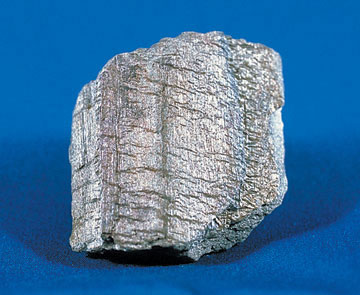 |
Phyllite | Foliated | Metamorphism of slate, but under greater heat and pressure than slate |
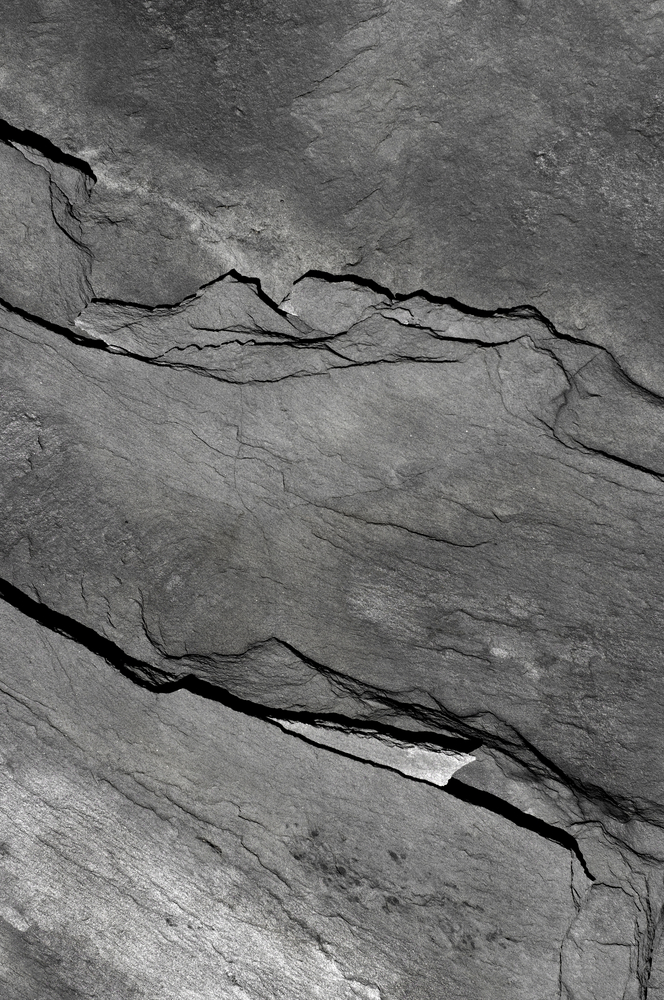 |
Schist | Foliated | Often derived from metamorphism of claystone or shale; metamorphosed under more heat and pressure than phyllite |
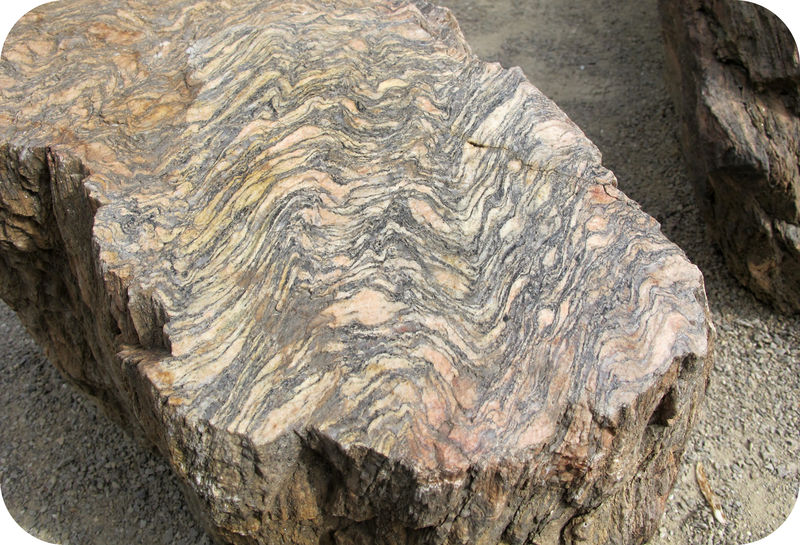 |
Gneiss | Foliated | Metamorphism of various different rocks, under extreme conditions of heat and pressure |
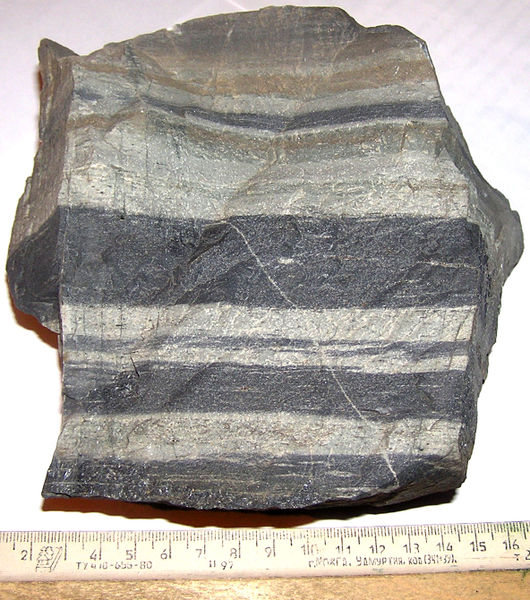 |
Hornfels | Non-foliated | Contact metamorphism of various different rock types |
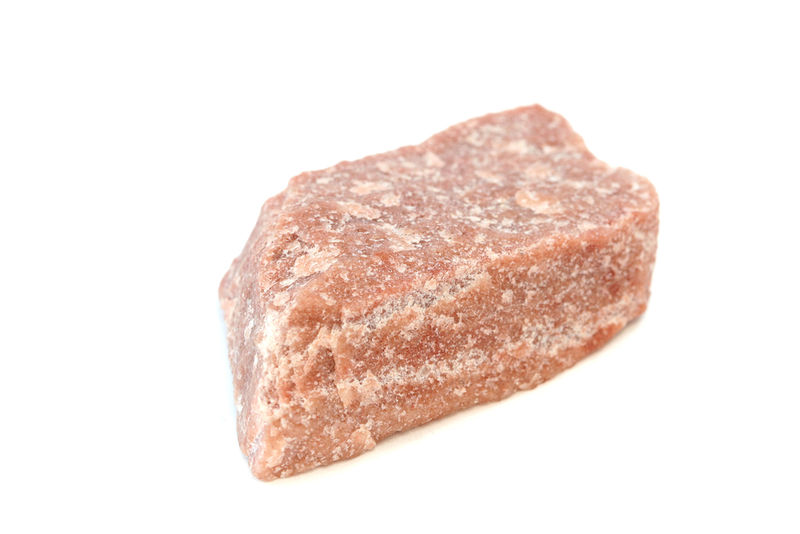 |
Quartzite | Non-foliated | Metamorphism of sandstone |
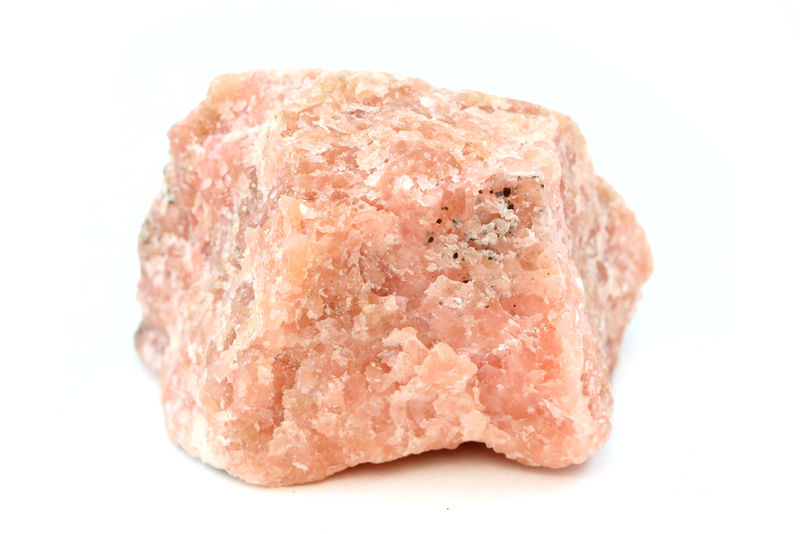 |
Marble | Non-foliated | Metamorphism of limestone |
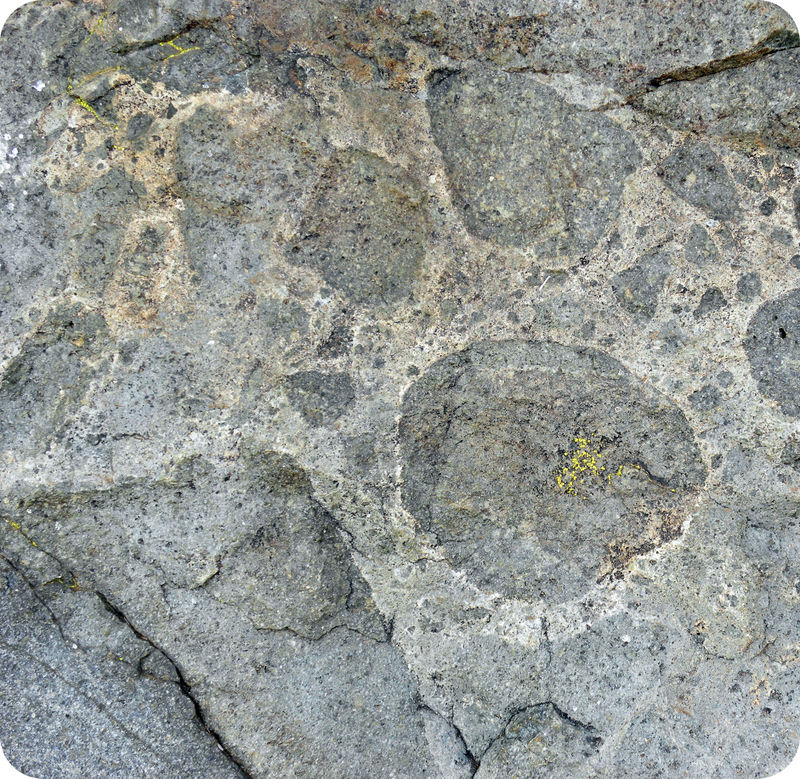 |
Metaconglomerate | Non-foliated | Metamorphism of conglomerate |
Metamorphic Rock Classification
| Foliated Metamorphic Rocks | ||||
|---|---|---|---|---|
| Crystal Size | Mineralogy | Protolith | Metamorphism | Rock Name |
| very fine | clay minerals | shale | low grade regional | slate |
| fine | clay minerals, biotite, muscovite | slate, shale | low grade regional | phyllite |
| medium to coarse | biotite, muscovite, quartz, garnet, plagioclase | slate, shale, basalt, sandstone | medium grade regional | schist |
| medium to coarse | amphibole, plagioclase, biotite | basalt | medium grade regional | amphibolite
(Note: may be unfoliated) |
| medium to coarse | plagioclase, orthoclase, quartz, biotite, amphibole, pyroxene | basalt, granite, shale, sandstone | high grade regional | gneiss |
| Unfoliated Metamorphic Rocks | ||||
| Crystal Size | Mineralogy | Protolith | Metamorphism | Rock Name |
| fine to coarse | quartz | sandstone | regional or contact | quartzite |
| fine to coarse | calcite | limestone | regional or contact | marble |
| fine | pyroxene, amphibole, plagioclase | shale | contact | hornfels |
Note that not all minerals listed in the mineralogy column will be present in every rock of that type and that some rocks may have minerals not listed here.
Uses of Metamorphic Rocks
Quartzite and marble are commonly used for building materials and artwork. Marble is beautiful for statues and decorative items such as vases (see an example in figure 3). Ground up marble is also a component of toothpaste, plastics, and paper.

Figure 3. Marble is used for decorative items and in art.
Quartzite is very hard and is often crushed and used in building railroad tracks (see figure 4). Schist and slate are sometimes used as building and landscape materials. Graphite, the “lead” in pencils, is a mineral commonly found in metamorphic rocks.
